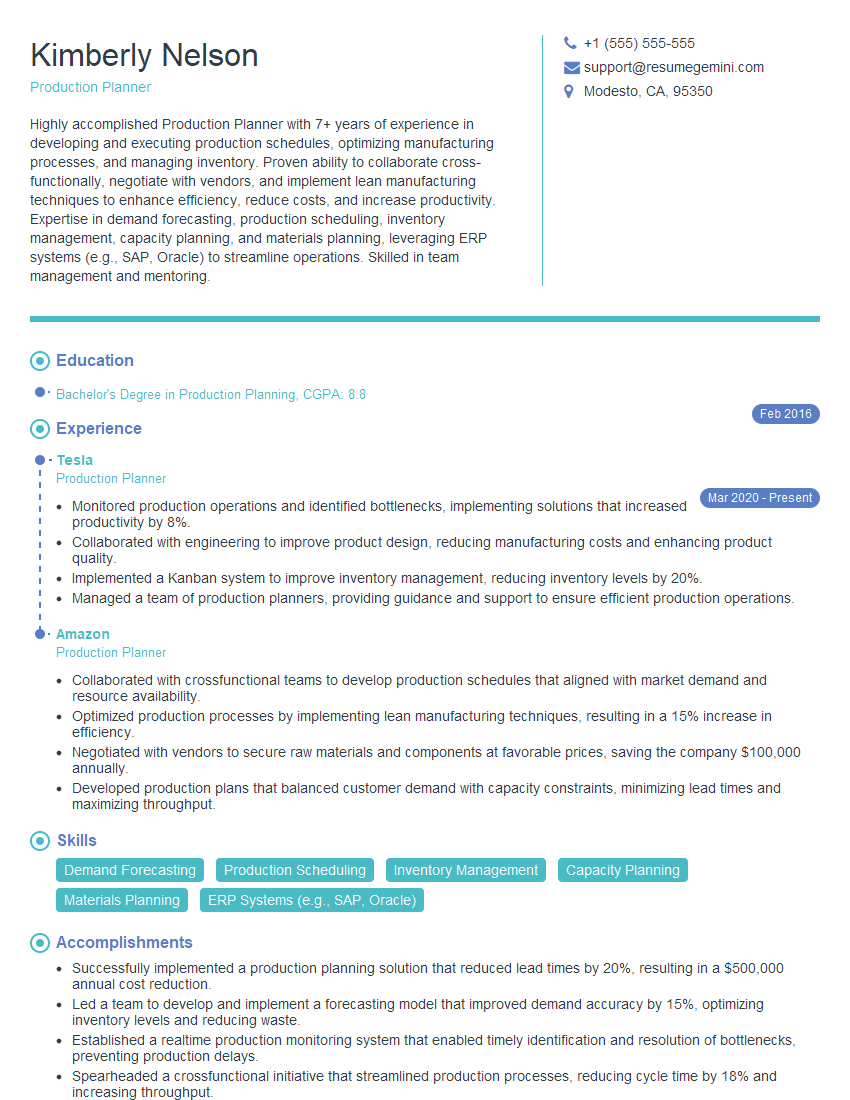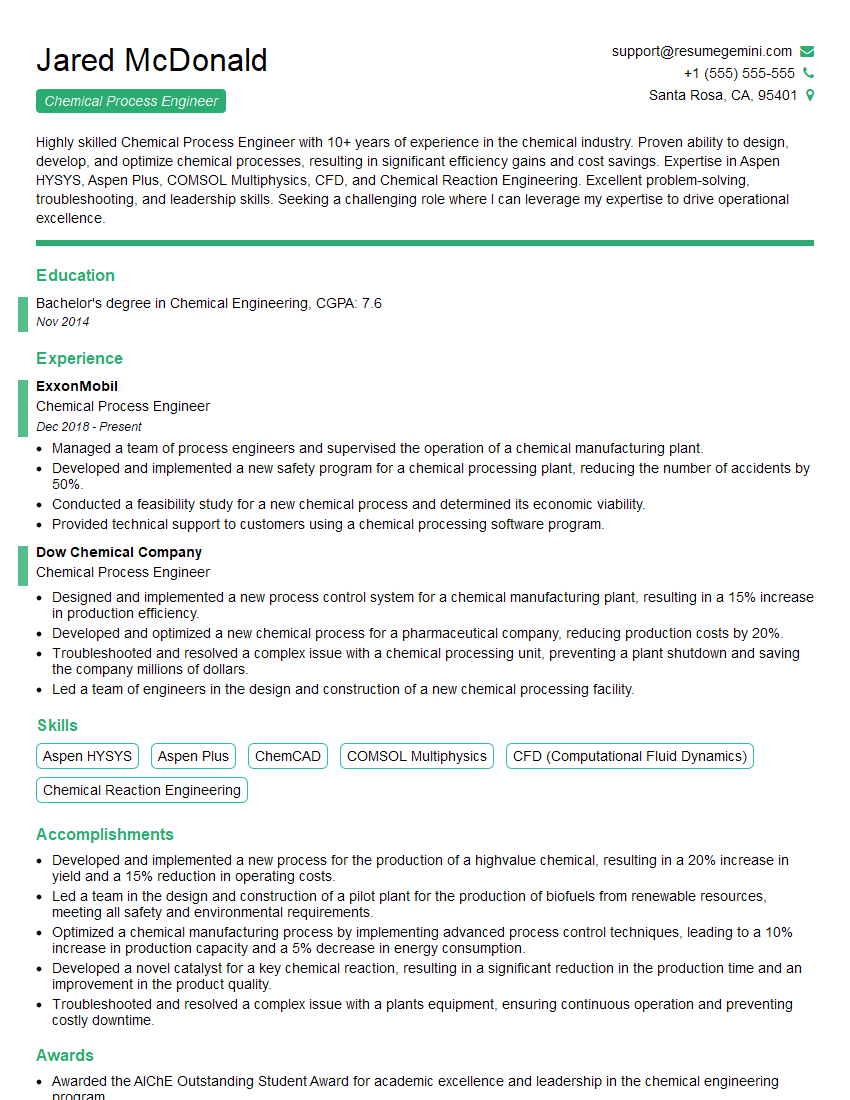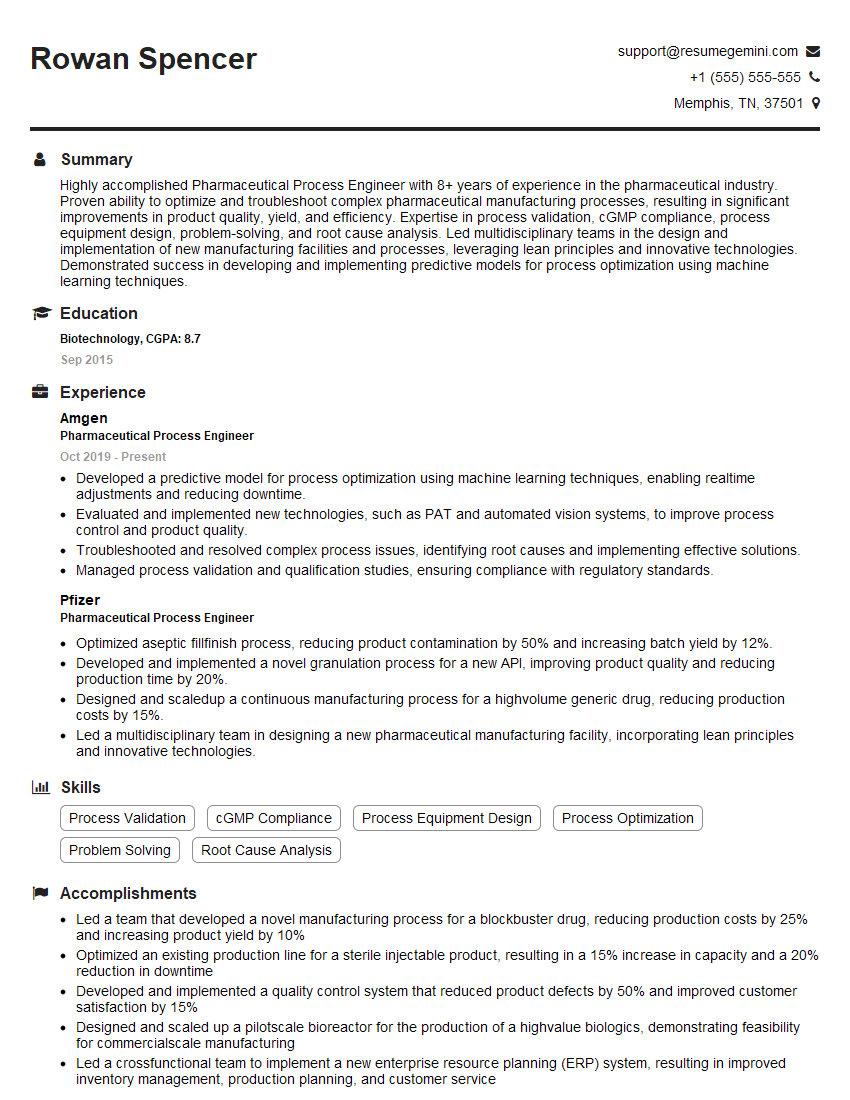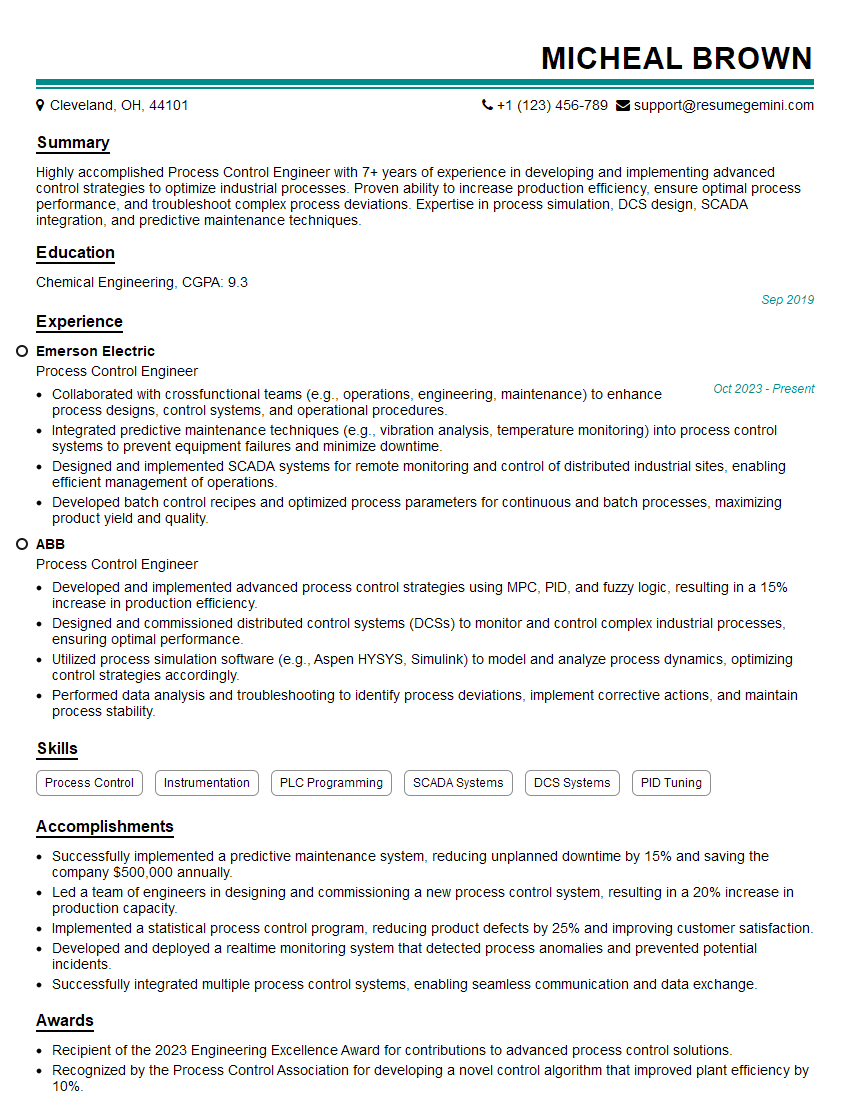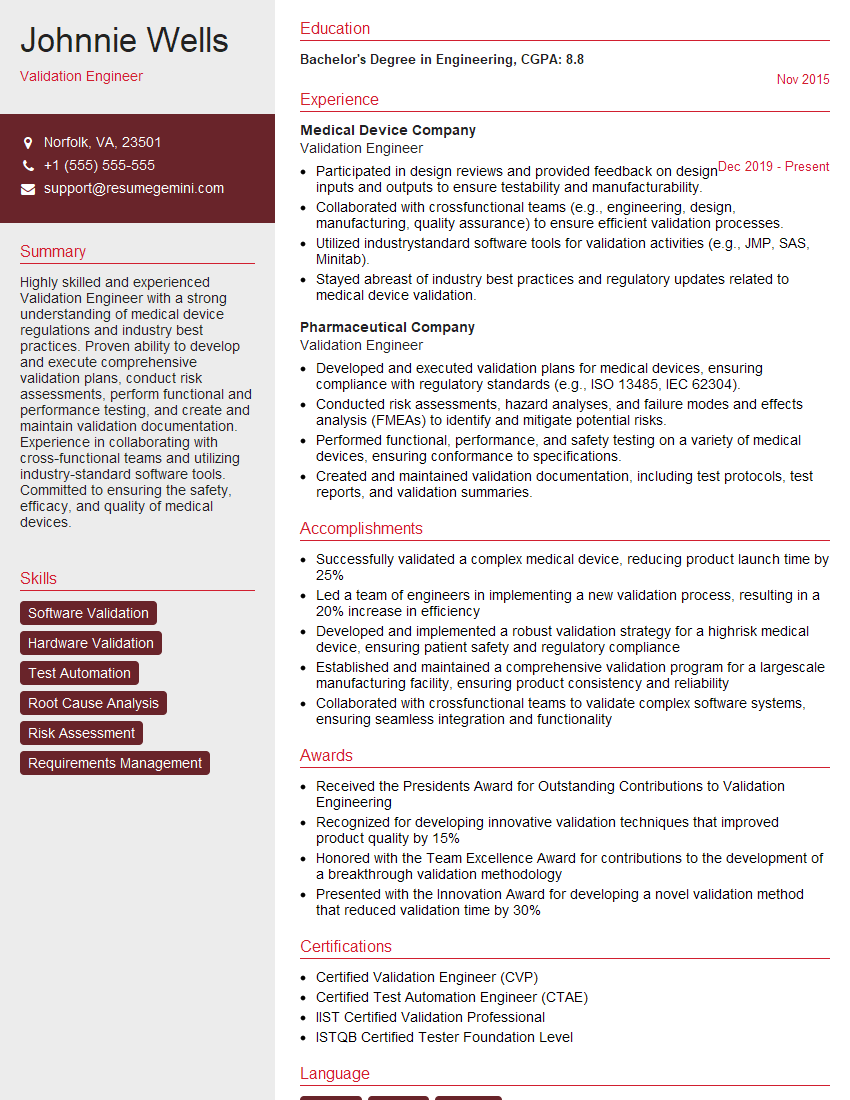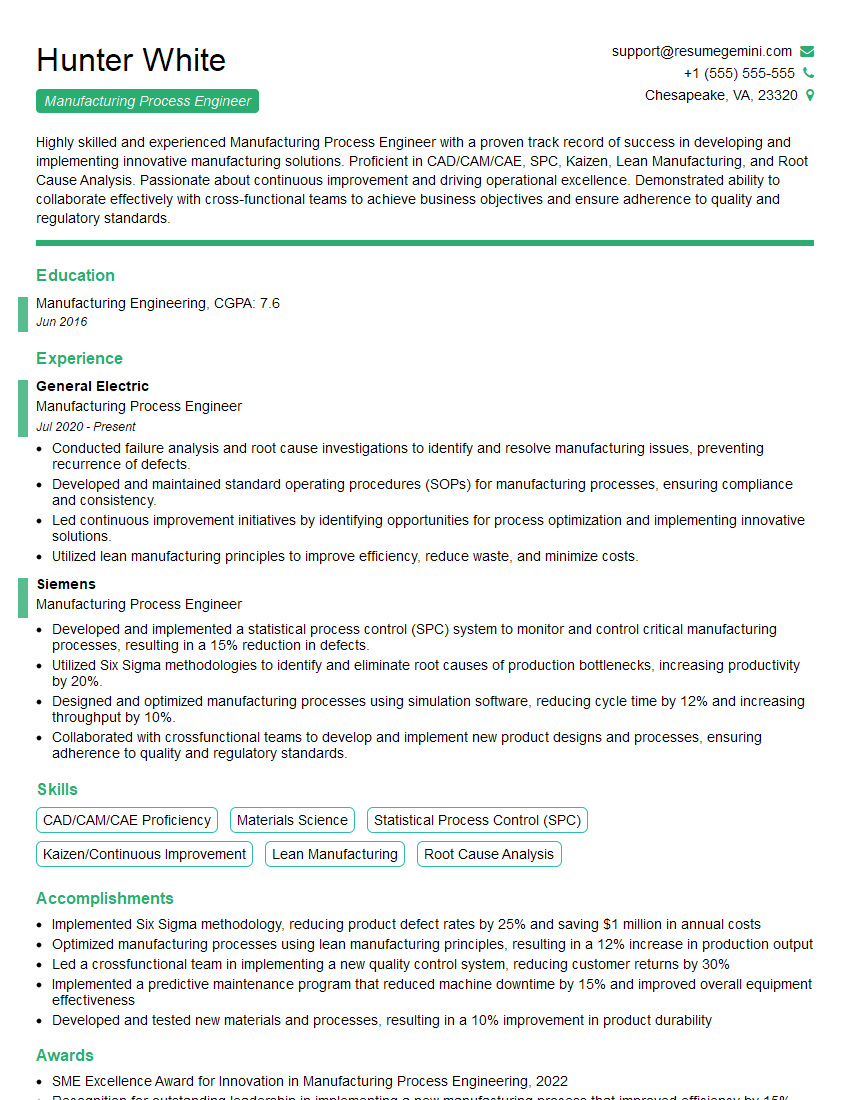Preparation is the key to success in any interview. In this post, we’ll explore crucial Batch and Recipe Management interview questions and equip you with strategies to craft impactful answers. Whether you’re a beginner or a pro, these tips will elevate your preparation.
Questions Asked in Batch and Recipe Management Interview
Q 1. Explain the difference between a batch process and a continuous process.
The core difference between batch and continuous processes lies in how materials are processed. In a batch process, a defined quantity of material is processed as a single unit, from start to finish, before another batch begins. Think of baking cookies: you mix all ingredients, bake one batch, and then start another. Each batch is independent. A continuous process, however, involves a constant flow of material through the system. Imagine a conveyor belt in a factory; materials are continually added and processed without distinct batch boundaries. Examples include oil refining or electricity generation.
- Batch: Discrete processing cycles, each with its own set of parameters and results. Ideal for smaller production volumes, high product variety, or specialized products.
- Continuous: Constant processing, optimized for large-scale, homogeneous product production. High efficiency for mass production but less flexible for product changes.
The choice between batch and continuous depends on factors like production scale, product variability, and required quality control. Often, hybrid approaches combine elements of both.
Q 2. Describe your experience with MES (Manufacturing Execution System) software.
I have extensive experience with MES (Manufacturing Execution System) software, having implemented and supported several systems across different manufacturing environments. My experience spans various MES functionalities, including batch record management, real-time data acquisition from shop floor equipment, production scheduling, and quality control integration. I’m proficient in using MES to track materials, labor, and equipment usage for accurate cost accounting and performance analysis. For instance, in one project, I helped implement an MES system that reduced production downtime by 15% by optimizing equipment scheduling and providing real-time alerts for potential issues. Furthermore, I’m familiar with various MES platforms, including [mention specific MES software you’ve worked with – e.g., Siemens Opcenter, Rockwell Automation FactoryTalk ProductionCenter, etc.], and understand their integration with ERP (Enterprise Resource Planning) systems.
Q 3. How do you ensure data integrity in batch record management?
Maintaining data integrity in batch record management is paramount for regulatory compliance (e.g., GMP, FDA 21 CFR Part 11) and accurate product traceability. My approach involves a multi-layered strategy:
- Electronic Batch Records (EBR): Utilizing EBR systems eliminates manual transcription errors and provides an auditable trail of all activities.
- Access Control and User Authentication: Restricting access to authorized personnel with unique usernames and passwords prevents unauthorized modifications.
- Data Validation: Implementing checks and balances, including range checks, reasonableness checks, and data consistency checks to ensure data accuracy and prevent invalid entries.
- Audit Trails: Comprehensive audit trails record all changes, including who made the change, when it was made, and the original and modified data. This allows for easy identification and investigation of potential data integrity issues.
- Data Backup and Recovery: Regular backups are essential to protect against data loss and ensure business continuity.
- Periodic Data Integrity Reviews: Regularly reviewing and validating data for accuracy helps identify potential problems early on.
In practice, this translates to clear procedures, thorough training, and regular audits to guarantee that batch records accurately reflect the manufacturing process.
Q 4. What are the key performance indicators (KPIs) you monitor in batch manufacturing?
The key performance indicators (KPIs) I monitor in batch manufacturing are designed to provide a holistic view of efficiency, quality, and cost-effectiveness. These typically include:
- Overall Equipment Effectiveness (OEE): Measures the effectiveness of equipment utilization, considering availability, performance, and quality.
- Batch Cycle Time: Tracks the total time required to complete a batch, from start to finish.
- Yield: Represents the percentage of usable product produced relative to the input materials.
- Throughput: Measures the total amount of product produced within a given time frame.
- Production Cost per Unit: Tracks the total cost of manufacturing each unit of product.
- Defect Rate: Indicates the percentage of defective products produced in a batch.
- On-Time Delivery Rate: Measures the percentage of batches delivered on or before the scheduled delivery date.
By regularly reviewing these KPIs, we can pinpoint areas for improvement and make data-driven decisions to optimize the manufacturing process.
Q 5. How do you troubleshoot issues related to deviations in batch recipes?
Troubleshooting deviations in batch recipes requires a systematic approach. I typically follow these steps:
- Identify the Deviation: Pinpoint the specific deviation from the established recipe or expected parameters. This could include discrepancies in raw materials, process parameters (temperature, pressure, time), or final product quality.
- Gather Data: Collect all relevant data from the batch record, including process parameters, raw material specifications, and quality control test results. Analyzing this data can often highlight the root cause of the deviation.
- Investigate Potential Causes: This involves considering various factors such as equipment malfunction, incorrect raw material usage, process parameter variations, or operator error. Root cause analysis (RCA) techniques, such as the 5 Whys, can be very effective here.
- Implement Corrective Actions: Once the root cause is identified, implement appropriate corrective actions to prevent recurrence. This might involve equipment maintenance, operator retraining, process parameter adjustments, or changes to the recipe itself.
- Document Findings: Meticulously document the deviation, the investigation process, the root cause analysis, and the corrective actions taken. This documentation is crucial for regulatory compliance and continuous improvement.
- Review and Update Procedures: Review the standard operating procedures (SOPs) to ensure they are accurate and effective in preventing future deviations.
A thorough and well-documented investigation is key to preventing similar deviations in the future. It also helps to build a robust understanding of the manufacturing process and continuously enhance it.
Q 6. Describe your experience with recipe validation and qualification.
My experience with recipe validation and qualification encompasses both the development and execution phases. Recipe validation ensures the established recipe consistently produces the desired product quality and quantity. Recipe qualification verifies that the manufacturing equipment and processes correctly execute the recipe. I’ve been involved in various stages, including:
- Defining Validation Parameters: Establishing specific parameters (e.g., critical process parameters, critical quality attributes) to be tested during validation.
- Developing Validation Protocols: Creating detailed protocols outlining the procedures for validating the recipe and equipment.
- Executing Validation Batches: Conducting multiple test batches to demonstrate consistent product quality and process performance.
- Analyzing Validation Data: Analyzing the collected data to ensure it meets predetermined acceptance criteria.
- Generating Validation Reports: Creating comprehensive reports that document the entire validation process, including results and conclusions.
- Qualification of Equipment: This involves demonstrating that the equipment used to perform the recipe is fit for its intended purpose. This might include IQ (Installation Qualification), OQ (Operational Qualification), and PQ (Performance Qualification).
Thorough recipe validation and qualification are critical for demonstrating product quality, regulatory compliance, and ultimately, patient safety in pharmaceutical and food industries.
Q 7. What are your methods for optimizing batch processes for efficiency and cost-effectiveness?
Optimizing batch processes for efficiency and cost-effectiveness requires a multifaceted approach. I typically focus on these areas:
- Process Optimization: Analyzing the current process using techniques like statistical process control (SPC) and Design of Experiments (DOE) to identify areas for improvement. This might involve adjusting process parameters, improving material handling, or optimizing equipment settings.
- Lean Manufacturing Principles: Implementing lean manufacturing techniques to eliminate waste, reduce cycle times, and improve overall efficiency. This often involves identifying and eliminating non-value-added activities.
- Automation: Automating repetitive tasks to increase efficiency and reduce operator error. This could involve implementing automated process control systems or robotics.
- Improved Material Management: Optimizing inventory management strategies to reduce material waste and ensure timely availability of raw materials. This includes using techniques such as Just-in-Time (JIT) inventory.
- Preventive Maintenance: Implementing a preventive maintenance program to reduce equipment downtime and maintain production efficiency.
- Data Analytics: Using data analytics to identify trends, predict potential issues, and make informed decisions to improve efficiency and reduce costs.
Ultimately, optimization is an ongoing iterative process that involves continuous monitoring, analysis, and improvement.
Q 8. Explain your approach to managing change control for batch recipes.
Managing change control for batch recipes is crucial for maintaining product quality and consistency. It involves a formal process to review, approve, and implement any modifications to existing recipes. This ensures that changes are well-documented, validated, and don’t negatively impact the final product.
My approach follows a structured methodology involving these steps:
- Change Request Submission: A formal request detailing the proposed change, rationale, and potential impact is submitted. This often includes a risk assessment.
- Review and Evaluation: A cross-functional team, including production, quality control, and R&D, reviews the request, evaluating its impact on the process, product quality, and regulatory compliance. We might use a change control form for this.
- Approval and Documentation: Once approved, the change is documented meticulously, including the date, approval signatures, and any supporting data. This usually involves a change control log.
- Implementation and Validation: The change is implemented, followed by thorough validation. This might include pilot batches to ensure the modified recipe produces the expected results.
- Post-Implementation Review: A post-implementation review is conducted to assess the effectiveness of the change and make any necessary adjustments.
For example, if we needed to switch a raw material supplier, the change control process would ensure that the new material meets the same specifications and the process is adapted accordingly. We’d validate the change by running comparative batches using both the old and new materials.
Q 9. How do you handle deviations from the prescribed batch recipe?
Deviations from a prescribed batch recipe are inevitable, but they need to be handled carefully to maintain quality and compliance. My approach focuses on immediate action, thorough documentation, and investigation.
- Immediate Action: The deviation is immediately documented, and corrective actions are taken to bring the process back under control. This might involve adjusting parameters or stopping the batch if necessary.
- Root Cause Analysis: A thorough investigation is carried out to determine the root cause of the deviation. This could involve analyzing process data, interviewing personnel, and reviewing equipment logs. Methods such as Fishbone Diagrams or 5 Whys are useful here.
- Corrective and Preventive Actions (CAPA): Based on the root cause analysis, corrective actions are implemented to address the immediate deviation and preventive actions to avoid similar deviations in the future. These are documented thoroughly.
- Deviation Report: A comprehensive deviation report is prepared, documenting the deviation, root cause, corrective actions, and preventive actions. This report is reviewed by relevant parties.
Imagine a situation where the temperature in a reactor deviates significantly from the set point. We would immediately document the deviation, investigate the cause (faulty sensor, control system malfunction), take corrective action (adjust temperature manually or repair the system), and develop preventive measures (regular equipment calibration, improved process control).
Q 10. How do you ensure compliance with regulatory requirements (e.g., GMP, FDA) in batch manufacturing?
Ensuring compliance with regulatory requirements like GMP (Good Manufacturing Practices) and FDA guidelines is paramount in batch manufacturing. This involves a multi-faceted approach:
- Standard Operating Procedures (SOPs): Clearly defined and documented SOPs for all aspects of batch manufacturing, from raw material handling to final product release, are essential. These SOPs must adhere to regulatory guidelines.
- Documentation and Record Keeping: Meticulous record-keeping of all batch processes, including raw materials used, process parameters, deviations, and testing results, is crucial. This data is retained for the duration required by regulatory agencies. Electronic Batch Records (EBR) are common in modern manufacturing.
- Quality Control Testing: Robust quality control testing at various stages of the manufacturing process ensures the final product meets quality and safety standards. This includes in-process and final product testing.
- Audits and Inspections: Regular internal audits and external inspections by regulatory agencies ensure adherence to guidelines. Preparing for these audits needs to be an ongoing process.
- Training: Comprehensive training of all personnel involved in batch manufacturing is vital to ensure everyone understands their responsibilities and the importance of compliance.
For instance, maintaining detailed batch records ensures traceability in case of a product recall. Regular equipment calibration and preventive maintenance prevent deviations and maintain compliance.
Q 11. What methods do you use to document and track batch history?
Documenting and tracking batch history is crucial for traceability, quality control, and regulatory compliance. I utilize a combination of manual and electronic methods:
- Batch Records: Detailed batch records are maintained for each batch, including date, time, raw materials used, process parameters (temperature, pressure, time), operator signatures, and test results. These records can be paper-based or electronic (EBR).
- Electronic Batch Record (EBR) Systems: EBR systems provide a centralized, electronic platform for managing batch records, enhancing traceability and reducing errors. They offer features like automated data capture and electronic signatures.
- Manufacturing Execution System (MES): An MES integrates various aspects of the manufacturing process, including recipe management, batch tracking, and quality control data, providing a holistic view of the batch history.
- Database Management: Batch history data is often stored in a database management system (DBMS) that allows for easy retrieval and analysis of data for trend analysis and reporting.
- Data Archiving: Batch records are archived securely according to regulatory requirements to ensure long-term data accessibility and integrity.
For example, if a quality issue is detected in a particular batch, we can use the batch history to trace the issue back to its origin and identify corrective actions. This is aided greatly by EBR and MES systems.
Q 12. Describe your experience with different types of batch control strategies.
I have experience with various batch control strategies, each suited to different scenarios. These strategies range from simple to highly complex:
- Open-Loop Control: This is a simple strategy where process parameters are set manually and not automatically adjusted based on feedback. It’s suitable for processes with high tolerances.
- Closed-Loop Control: Utilizes feedback mechanisms to adjust process parameters automatically to maintain desired set points. This is more precise than open-loop and frequently uses sensors and actuators.
- Advanced Process Control (APC): Employs more sophisticated algorithms like model predictive control (MPC) to optimize the process and maintain quality under varying conditions. This is useful for complex processes with multiple variables.
- Real-Time Release Testing (RTRT): Allows for the release of batches based on real-time quality data, reducing lead times compared to traditional methods where testing is done only after the batch is complete.
The selection of a batch control strategy depends on factors such as the complexity of the process, required precision, and cost considerations. For example, a simple mixing process might only need open-loop control, while a complex fermentation process might require APC.
Q 13. How do you manage raw material inventory for batch manufacturing?
Managing raw material inventory for batch manufacturing requires careful planning and control to avoid shortages, spoilage, and excess inventory. My approach involves these key elements:
- Material Requirements Planning (MRP): An MRP system helps predict and plan raw material needs based on the production schedule and bill of materials (BOM).
- Inventory Management System (IMS): An IMS tracks raw material quantities, locations, and expiration dates, ensuring proper stock levels and preventing waste.
- Supplier Management: Establishing reliable relationships with suppliers ensures timely delivery of quality raw materials. This often involves defining service level agreements (SLAs).
- First-In, First-Out (FIFO): A FIFO inventory system ensures that older materials are used before newer ones, minimizing the risk of spoilage or expiration.
- Quality Control: Incoming raw materials undergo rigorous quality control testing before being accepted into the inventory.
For instance, an effective MRP system would accurately predict the demand for raw materials based on production forecasts, allowing for timely procurement and avoiding stockouts. Regular inventory audits and a well-maintained IMS prevent material obsolescence.
Q 14. Explain your experience with statistical process control (SPC) in batch processes.
Statistical Process Control (SPC) is essential for monitoring and improving batch processes. It utilizes statistical methods to identify variations and potential issues in the manufacturing process.
- Control Charts: Various control charts, such as X-bar and R charts, are used to monitor process parameters (temperature, pressure, yield) over time. These charts visually display data and identify trends or outliers.
- Process Capability Analysis: Process capability analysis determines whether a process is capable of consistently producing products that meet specifications. This involves calculating Cp and Cpk indices.
- Data Collection and Analysis: Systematic data collection and analysis are critical for effective SPC. This data might come from sensors, instruments, or manual measurements.
- Root Cause Analysis: When control charts indicate out-of-control conditions, a root cause analysis is initiated to identify and correct underlying issues.
- Process Improvement: SPC helps identify opportunities to improve the consistency and efficiency of batch processes by pinpointing and addressing variability.
For example, if a control chart for the yield of a particular batch process shows a downward trend, we would investigate the root cause, which might include equipment malfunction, raw material variations, or process parameter drift. Addressing the root cause would then improve process consistency and yield.
Q 15. Describe your experience with root cause analysis of batch process failures.
Root cause analysis (RCA) for batch process failures is crucial for preventing recurrence. It’s a systematic investigation to identify the underlying causes, not just the symptoms. My approach involves a structured methodology, often using techniques like the ‘5 Whys’ or Fishbone diagrams.
For instance, if a batch fails due to low yield, simply stating ‘low yield’ isn’t sufficient. I’d systematically ask ‘why’ five times (or more) to uncover the root cause. This might reveal issues such as inaccurate ingredient measurement leading to incorrect ratios, a faulty sensor causing improper temperature control, or even a poorly trained operator.
After identifying the root cause, I document it meticulously, including all evidence, and propose corrective actions. This could involve retraining staff, updating equipment, improving process controls, or revising standard operating procedures (SOPs). I also ensure that these corrective actions are validated to prevent the issue from reoccurring.
Furthermore, I leverage data analysis tools to identify trends and patterns in failures. This allows for proactive measures – predicting potential problems before they arise, rather than reacting to them after they’ve occurred. For example, if consistent failures are linked to specific equipment at a certain time of day, this data reveals areas needing improvement.
Career Expert Tips:
- Ace those interviews! Prepare effectively by reviewing the Top 50 Most Common Interview Questions on ResumeGemini.
- Navigate your job search with confidence! Explore a wide range of Career Tips on ResumeGemini. Learn about common challenges and recommendations to overcome them.
- Craft the perfect resume! Master the Art of Resume Writing with ResumeGemini’s guide. Showcase your unique qualifications and achievements effectively.
- Don’t miss out on holiday savings! Build your dream resume with ResumeGemini’s ATS optimized templates.
Q 16. How do you ensure accurate and timely reporting of batch data?
Accurate and timely batch data reporting is essential for efficient operation and regulatory compliance. My strategy involves a multi-faceted approach. First, we implement a robust data acquisition system, integrating sensors and process controllers directly into a centralized database. This minimizes manual data entry, reducing errors and speeding up the process.
Secondly, I utilize a sophisticated reporting system that automatically generates various reports, such as batch records, yield summaries, and quality control metrics. These reports are customized based on the needs of various stakeholders – from production managers to quality assurance teams. These reports are regularly reviewed and validated for accuracy.
Thirdly, I incorporate data validation checks at every stage of the process. This includes range checks, plausibility checks, and cross-referencing against established process parameters. If anomalies are detected, automated alerts are triggered, enabling immediate investigation and rectification.
Finally, real-time dashboards provide a visual overview of key performance indicators (KPIs), facilitating timely decision-making. This allows for immediate identification of any deviations from expected performance and prompt intervention.
Q 17. What are your preferred methods for training personnel on batch process procedures?
Effective training is critical for ensuring consistent and safe batch processing. My preferred method involves a blended learning approach, combining classroom sessions, hands-on practical training, and e-learning modules.
Classroom sessions cover theoretical aspects such as process chemistry, equipment operation, and safety regulations. These sessions are interactive, incorporating group discussions and case studies. Hands-on training allows trainees to operate equipment under the supervision of experienced personnel in a simulated environment before real-world application. This approach is crucial to avoid mistakes on the production floor.
E-learning modules provide flexible, self-paced learning, reinforcing key concepts covered in the classroom and practical training. They include interactive exercises, quizzes, and simulations to improve knowledge retention. This combination ensures a comprehensive approach to personnel training, leading to increased competency and safety.
Regular refresher courses and competency assessments are scheduled to ensure ongoing compliance with procedures and to adapt to process improvements or updated regulations. This continuous improvement approach maintains a high standard of operational excellence.
Q 18. How do you use data analytics to improve batch process efficiency?
Data analytics plays a vital role in improving batch process efficiency. I utilize statistical process control (SPC) techniques to monitor process parameters and identify sources of variability. This helps to pinpoint areas for improvement, reducing waste and increasing yield. For instance, analyzing historical data may reveal that slight temperature fluctuations at a particular stage significantly impact the final product’s quality.
Predictive modeling can help anticipate potential problems before they arise. By analyzing historical data on equipment failures, for example, we can predict when maintenance is needed, preventing unexpected downtime. Machine learning algorithms can also be used to optimize process parameters, resulting in improved efficiency and reduced costs.
I use data visualization tools to represent complex data in a user-friendly format. This enables stakeholders to easily understand key process metrics and identify areas requiring attention. For example, a control chart visually displays process variability, allowing quick identification of out-of-control conditions. This provides immediate insights to operators and management.
Q 19. Explain your understanding of automation in batch processing.
Automation in batch processing significantly improves efficiency, consistency, and safety. This involves using automated systems to control and monitor various aspects of the process, reducing manual intervention and human error.
Automation can range from simple Programmable Logic Controllers (PLCs) controlling individual equipment to sophisticated Manufacturing Execution Systems (MES) managing the entire batch process from start to finish. An MES integrates data from various sources, providing real-time process visibility and allowing for optimization through automated decision-making. For example, automated systems can adjust ingredient ratios based on real-time sensor readings, ensuring consistent product quality.
Automation benefits extend beyond efficiency. It enhances safety by minimizing human exposure to hazardous materials and reducing the risk of human error. It also improves data accuracy and traceability, facilitating compliance with regulatory requirements. Automated systems provide detailed records of each batch, facilitating detailed analysis and process improvement.
Q 20. What are the advantages and disadvantages of different batch scheduling algorithms?
Various batch scheduling algorithms exist, each with its advantages and disadvantages. The choice depends on the specific needs of the production environment.
First-Come, First-Served (FCFS): This is simple to implement but can lead to inefficient use of resources if longer batches block shorter ones.
Shortest Job First (SJF): This minimizes average waiting time, but requires knowledge of batch duration beforehand, which may not always be possible.
Priority Scheduling: This assigns priorities to batches based on factors like urgency or importance. It’s flexible but requires a well-defined prioritization scheme to avoid biases.
Shortest Processing Time First (SPT): Similar to SJF but focuses on processing time rather than overall job time (including waiting).
For example, in a pharmaceutical setting, critical batches requiring strict quality control might be given priority over others, impacting overall production flow. The choice involves careful consideration of factors like resource constraints, production deadlines, and product criticality.
Q 21. How do you handle equipment downtime during batch processing?
Equipment downtime during batch processing can significantly disrupt production and impact efficiency. My approach focuses on proactive and reactive strategies to minimize the impact.
Proactive measures include implementing a robust preventive maintenance program, using predictive analytics to anticipate potential equipment failures, and ensuring sufficient spare parts are readily available. This minimizes unexpected downtime and reduces the risk of prolonged production delays.
Reactive strategies involve swift troubleshooting and repair procedures. This involves a well-trained maintenance team with access to necessary tools and expertise. Detailed procedures are in place to address common equipment issues promptly. A standardized troubleshooting methodology is implemented, allowing quick identification and resolution of the problem.
During downtime, alternative strategies are implemented where possible. This could involve re-scheduling batches, utilizing backup equipment, or prioritizing other tasks. A clear communication plan keeps all stakeholders informed of the situation and any potential impacts on production schedules. Post-incident analysis is crucial to identify the root cause of the downtime and implement corrective measures to prevent recurrence.
Q 22. Describe your experience with designing and implementing batch control systems.
Designing and implementing batch control systems involves a multifaceted approach, encompassing everything from initial process understanding to final system validation. It begins with a thorough analysis of the manufacturing process, identifying critical parameters and control points. This often involves creating detailed process flow diagrams and defining control strategies for each stage. For example, in a pharmaceutical manufacturing process, I’ve worked on systems that precisely control temperature, pressure, and mixing speed within a bioreactor, using programmable logic controllers (PLCs) and supervisory control and data acquisition (SCADA) systems. These systems incorporate feedback loops to maintain optimal process conditions. We then develop detailed specifications for hardware (sensors, actuators, PLCs) and software, ensuring seamless integration and data consistency. Following development, rigorous testing and validation are crucial. This includes simulating various scenarios, performing functional tests, and ensuring the system adheres to all relevant regulatory guidelines such as GMP (Good Manufacturing Practices). Finally, comprehensive documentation and training are vital for smooth operation and maintenance.
Q 23. What are some common challenges in managing complex batch recipes?
Managing complex batch recipes presents several challenges. One key issue is maintaining recipe consistency and repeatability across multiple batches and production runs. Slight variations in raw material properties, equipment performance, or environmental conditions can impact the final product. Think of baking a cake – even minor changes in ingredient amounts or oven temperature can significantly alter the outcome. Another challenge lies in efficiently managing changes to recipes. Modifying a recipe necessitates thorough testing and validation to ensure the change doesn’t compromise product quality or safety. Furthermore, managing the large datasets generated by batch processes, including real-time data and historical records, requires robust data management systems. Effective tracking and analysis of this data are critical for troubleshooting and continuous improvement. Finally, integrating various systems (e.g., ERP, MES) to enable seamless data flow and traceability across the entire production process can be complex. In one project, integrating a new MES system with legacy equipment required extensive custom programming and rigorous testing to ensure compatibility and data integrity.
Q 24. How do you ensure the traceability of materials and products throughout the batch process?
Ensuring material and product traceability throughout the batch process is paramount for quality control and regulatory compliance. This involves implementing a robust tracking system that uniquely identifies each batch and its components. This can involve assigning unique batch numbers, scanning barcodes or QR codes, and utilizing RFID tags for real-time tracking. In pharmaceutical manufacturing, for instance, each raw material is tracked from its origin through to the final product. This includes recording details such as supplier information, lot numbers, and testing results. This information is meticulously documented in batch records. The batch records must include details of all processing steps, including equipment used, process parameters (temperature, pressure, time), and personnel involved. Software solutions are crucial in managing this data efficiently, providing automated tracking and generating comprehensive reports. A well-designed system allows for easy retrieval of all relevant information for any given batch, enabling efficient investigation in case of non-conformances and supporting compliance audits.
Q 25. How do you use software or tools to manage batch records effectively?
Managing batch records effectively relies heavily on dedicated software solutions. Manufacturing Execution Systems (MES) are commonly used for this purpose. These systems provide centralized control, automating data collection, tracking, and reporting related to batch production. MES systems can integrate with other enterprise systems, such as ERP (Enterprise Resource Planning) and LIMS (Laboratory Information Management Systems) enabling seamless data flow. For example, an MES system can automatically capture data from sensors and instruments during a batch run, recording parameters like temperature, pressure, and flow rates in real time. This data is then stored in a secure database for future analysis and reporting. The system can also generate various reports, including batch production reports, deviations reports, and audit trails. Further, these systems often support electronic batch records (EBR), eliminating the need for paper-based records and streamlining the auditing process. Using a robust MES system significantly improves data integrity and efficiency, allowing for real-time monitoring and proactive issue resolution.
Q 26. How do you prioritize tasks when multiple batches are running concurrently?
Prioritizing tasks when multiple batches are running concurrently requires a strategic approach, often employing scheduling algorithms and resource allocation techniques. Factors to consider include due dates, process duration, equipment availability, and raw material availability. Prioritization can be based on various criteria such as shortest processing time (SPT), earliest due date (EDD), or criticality of the product. In some cases, a combination of these criteria might be used. Visual tools like Gantt charts can help visualize the schedule and identify potential conflicts or delays. Sophisticated scheduling software can optimize resource allocation and minimize idle time. For instance, if two batches require the same reactor, the software would intelligently schedule them to minimize downtime. Furthermore, real-time monitoring of the production floor allows for dynamic adjustments to the schedule if unexpected events occur, such as equipment failure or material delays. Prioritization decisions are carefully documented to maintain transparency and ensure accountability.
Q 27. Describe your experience with different types of batch reactors or equipment.
My experience encompasses various types of batch reactors and equipment, including stirred tank reactors (STRs), jacketed kettles, fluidized bed reactors, and various types of mixing and conveying systems. STRs are commonly used for liquid-phase reactions, offering excellent mixing capabilities. Jacketed kettles provide precise temperature control, critical for many chemical processes. Fluidized bed reactors are advantageous for gas-solid reactions, ensuring uniform product quality. The selection of the appropriate reactor depends entirely on the specific process requirements and product characteristics. I’ve worked on systems controlling various ancillary equipment as well, including pumps, valves, and sensors, which are vital for precise control of the entire batch process. Furthermore, I have experience integrating different types of equipment from multiple vendors, ensuring seamless data flow and interoperability between the systems. Understanding the specific capabilities and limitations of different reactor types is critical for effective process design and optimization. For example, the selection of an impeller type in an STR is critical for achieving optimal mixing and heat transfer.
Q 28. How do you maintain the accuracy and consistency of batch recipes over time?
Maintaining the accuracy and consistency of batch recipes over time requires a rigorous quality control system. Regular calibration and validation of all equipment involved in the process is crucial. This ensures that the equipment operates as intended and produces consistent results. Raw material specifications should be carefully defined and regularly reviewed, accounting for variations in supplier sources or manufacturing processes. Periodic revalidation of the manufacturing process itself, often involving multiple batches, helps ensure that the recipe continues to produce the expected results. Version control of the recipes themselves is critical. Any changes to the recipe should be documented, validated, and approved according to established procedures. This ensures complete traceability and enables quick retrieval of past versions if necessary. Additionally, using a robust data management system for storing and analyzing batch data allows for continuous improvement and identification of trends, potentially preventing subtle recipe degradation over time. A well-designed system, combining meticulous record-keeping, process validation, and continuous monitoring, is essential for maintaining the accuracy and consistency of batch recipes.
Key Topics to Learn for Batch and Recipe Management Interview
- Batch Processing Fundamentals: Understanding batch scheduling, execution, and monitoring. Explore different batch processing frameworks and their strengths.
- Recipe Management Systems: Learn about designing, implementing, and managing recipe databases. Consider version control, access control, and data integrity within these systems.
- Data Validation and Error Handling: Master techniques for validating input data used in batch processes and recipes. Understand strategies for handling errors and exceptions gracefully.
- Performance Optimization: Explore methods to optimize batch processing performance, including techniques for efficient data processing and resource management.
- Scalability and Reliability: Understand how to design batch and recipe management systems that can scale to handle increasing data volumes and maintain high reliability.
- Security Considerations: Discuss security best practices for protecting sensitive data within batch and recipe management systems, including access control and data encryption.
- Integration with Other Systems: Explore how batch and recipe management systems integrate with other enterprise systems, such as ERP, MES, or SCADA systems.
- Troubleshooting and Debugging: Develop your skills in identifying and resolving issues in batch processes and recipes. Understand log analysis and debugging techniques.
- Testing and Validation: Learn about different testing methodologies (unit, integration, system) relevant to batch and recipe management systems. Understand validation procedures to ensure data accuracy and process integrity.
Next Steps
Mastering Batch and Recipe Management opens doors to exciting career opportunities in various industries, offering substantial growth potential. A strong understanding of these concepts is highly valued by employers seeking efficient and reliable production processes. To maximize your job prospects, focus on crafting an ATS-friendly resume that highlights your relevant skills and experience. ResumeGemini is a trusted resource to help you build a professional and impactful resume. We provide examples of resumes tailored to Batch and Recipe Management to guide you in showcasing your qualifications effectively.
Explore more articles
Users Rating of Our Blogs
Share Your Experience
We value your feedback! Please rate our content and share your thoughts (optional).
What Readers Say About Our Blog
Interesting Article, I liked the depth of knowledge you’ve shared.
Helpful, thanks for sharing.
Hi, I represent a social media marketing agency and liked your blog
Hi, I represent an SEO company that specialises in getting you AI citations and higher rankings on Google. I’d like to offer you a 100% free SEO audit for your website. Would you be interested?


